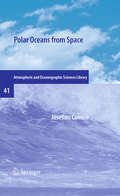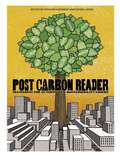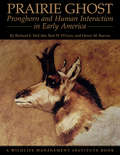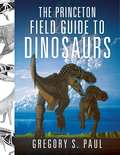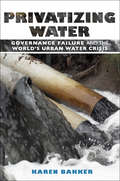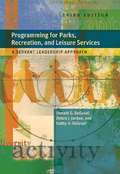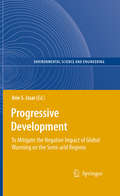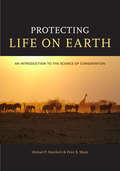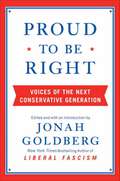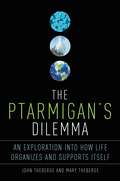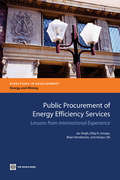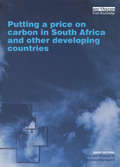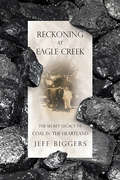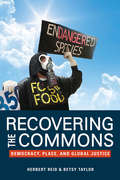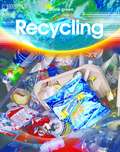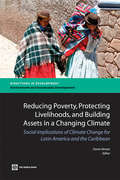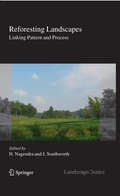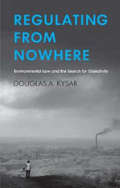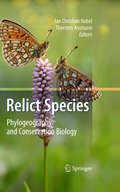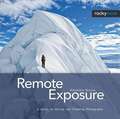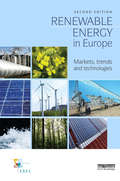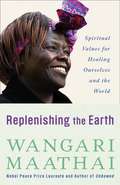- Table View
- List View
Polar Oceans from Space
by Josefino ComisoThe book presents a wealth of material about the polar oceans, more specifically the ice-covered areas and peripheral seas. It provides a detailed history of the changing climate of the polar oceans as observed by satellite sensors in the last three decades. The satellite research data show spatial distributions of surface temperature, sea ice, albedo, chlorophyll concentration, clouds, ocean color and sea level pressure. The book discusses remote sensing techniques and algorithms used to transform digital data to geophysical parameters, to process and analyze the data, the limitations of these data and the enormous potential in the use of this data. The main goal of the book is the presentation of results from studies of the time evolution of polar surfaces as observed by satellite sensors and their relevance to the study of cryospheric and ocean processes and climate change. The book contains about 150 satellite images of surface parameters which reveal that from month to month and from one year to another the Earth is changing. Although the historical record of about three decades of continuous satellite observation is relatively short, these measurements have provided useful insights into the current state of the polar environment and have served as a powerful tool for studying the processes that govern the Earth's climate system. The advent of even more sophisticated technology, including international ventures like the Global Earth Observation System of all Systems (GEOSS), will speed the progress. The advances in understanding of the Earth's climate engine, including the crucial role played by the polar oceans, have been tremendous, and people look forward to being able to forecast effectively the state of the planet in the immediate and foreseeable future.
Post Carbon Reader: Managing the 21st Century's Sustainability Crises
by Richard Heinberg Daniel LerchHow do population, water, energy, food, and climate issues impact one another? What can we do to address one problem without making the others worse? The Post Carbon Reader features essays by some of the world's most provocative thinkers on the key issues shaping our new century, from renewable energy and urban agriculture to social justice and community resilience. This insightful collection takes a hard-nosed look at the interconnected threats of our global sustainability quandary and presents some of the most promising responses. Book jacket.
Post-Kyoto International Climate Policy: Implementing Architectures for Agreement
by Joseph E. Aldy Robert N. StavinsThe Harvard Project on International Climate Agreements is a global, multi-disciplinary effort intended to help identify the key design elements of a scientifically sound, economically rational, and politically pragmatic post-2012 international policy architecture for addressing the threat of climate change. It has commissioned leading scholars to examine a uniquely wide range of core issues that must be addressed if the world is to reach an effective agreement on a successor regime to the Kyoto Protocol. The purpose of the project is not to become an advocate for any single policy but to present the best possible information and analysis on the full range of options concerning mitigation, adaptation, technology, and finance. The detailed findings of the Harvard Project are reported in this volume, which contains twenty-seven specially commissioned chapters. A companion volume summarizing the main findings of this research is published separately as Post-Kyoto International Climate Policy: Summary for Policymakers.
Prairie Ghost: Pronghorn and Human Interaction in Early America (G - Reference, Information And Interdisciplinary Subjects Ser.)
by Richard E. McCabe Henry M. Reeves Bart W. O'GaraA Wildlife Management Institute Book In this lavishly illustrated volume Richard E. McCabe, Bart W. O'Gara and Henry M. Reeves explore the fascinating relationship of pronghorn with people in early America, from prehistoric evidence through the Battle of Little Bighorn in 1876. The only one of fourteen pronghorn-like genera to survive the great extinction brought on by human migration into North America, the pronghorn has a long and unique history of interaction with humans on the continent, a history that until now has largely remained unwritten. With nearly 150 black-and-white photographs, 16 pages of color illustrations, plus original artwork by Daniel P. Metz, Prairie Ghost: Pronghorn and Human Interaction in Early America tells the intriguing story of humans and these elusive big game mammals in an informative and entertaining fashion that will appeal to historians, biologists, sportsmen and the general reader alike. Winner of the Wildlife Society's Outstanding Book Award for 2005
The Princeton Field Guide to Dinosaurs
by Gregory S. PaulThis lavishly illustrated volume is the first authoritative dinosaur book in the style of a field guide. World-renowned dinosaur illustrator and researcher Gregory Paul provides comprehensive visual and textual coverage of the great Mesozoic animals that gave rise to the living dinosaurs, the birds. Incorporating the new discoveries and research that are radically transforming what we know about dinosaurs, this book is distinguished both by its scientific accuracy and the quality and quantity of its illustrations. It presents thorough descriptions of more than 735 dinosaur species and features more than 600 color and black-and-white images, including unique skeletal drawings, "life" studies, and scenic views--illustrations that depict the full range of dinosaurs, from small, feathered creatures to whale-sized supersauropods. Heavily illustrated species accounts of the major dinosaur groups are preceded by an extensive introduction that covers dinosaur history and biology, the extinction of nonavian dinosaurs, the origin of birds, and the history of dinosaur paleontology--and that also gives a taste of what it might be like to travel back to the time of the dinosaurs. The Princeton Field Guide to Dinosaursis a must-have for anyone who loves dinosaurs, from the amateur enthusiast to the professional paleontologist. The first authoritative field guide to dinosaurs Covers more than 735 species Beautiful, large-format volume Lavishly illustrated throughout, with more than 600 color and black-and-white drawings and figures, including: More than 130 color life studies, including scenic views Close to 450 skeletal, skull, head, and muscle drawings 8 color paleo-distribution maps Color timeline Describes anatomy, physiology, locomotion, reproduction, and growth of dinosaurs, as well as the origin of birds and the extinction of nonavian dinosaurs
Privatizing Water: Governance Failure and the World's Urban Water Crisis (Oxford Geographical And Environmental Studies Ser.)
by Karen BakkerPrivatization of water suply is an emotive and controversial topic. The 'British model' of water privatization is unique: no other country has entirely privatized its water supply and sewerage systems. This book analyzes the socio-economic and environmental dimensions of privatization inEngland and Wales. It examines the implications of privatization for consumers, environmental management, and the water supply industry.
Programming for Parks, Recreation, and Leisure Services: A Servant Leadership Approach (3rd Edition)
by Donald G. Degraaf Debra J. Jordan Kathy H. DegraafThis book is about the art and science of the complete programming process. The authors strive to go beyond merely presenting the knowledge and skills needed to provide quality programs; they suggest the integration of values into this process. They do this from a servant leadership perspective.
Progressive Development
by Arie S. IssarThe book is based on the results of the investigations of the authors in the semi-arid and arid regions (ASAR) of the globe. These investigations brought to the conclusion that the warming climate will cause the drying up of the water resources in these regions. In this case the principles of Sustainable Development will not be able to avert forthcoming catastrophes. These conclusions brought to the compilation of the policy of "Progressive Development", emphasising investment in the development of new water resources and changing the natural environments while advancing the local populations on the dimension of knowledge by education.
Protecting Life on Earth
by Peter B. Moyle Michael Paul MarchettiWritten to be accessible to any college-level reader, Protecting Life on Earth offers a non-technical, yet comprehensive introduction to the growing field of conservation science. This multifaceted exploration of our current biodiversity crisis delivers vivid examples throughout, including features on some of nature's most compelling wildlife. Beginning with a brief introduction to environmental history, the text introduces the central concepts of evolution and ecology, and covers several major issues related to the conservation of biodiversity including extinction, climate change, sustainability, conservation law, and invasive species. It also touches on adjacent disciples such as economics and sociology as they relate to conservation. The text even includes practical advice on the decisions we make every day--how we spend our money, where we live and work, what we eat and buy. Throughout, Protecting Life on Earth underscores the ways in which our future is tied to that of Earth's threatened species, and demonstrates exactly why conservation is so vitally important for us all.
Proud to Be Right: Voices of the Next Conservative Generation
by Jonah GoldbergIn Proud to Be Right, Jonah Goldberg, the New York Times bestselling author of Liberal Fascism, presents voices of the next Conservative generation. A fresh and provocative collection of lively political writing from right wing writers under the age of 30, Proud to Be Right rebuts the conventional wisdom that Generation Y is a uniformly liberal demographic—and that intelligent young people today fall blindly into the Barack Obama camp.
The Ptarmigan's Dilemma: An Ecological Exploration into the Mysteries of Life
by Mary Theberge John ThebergeDrawing on breakthrough research in evolution, genetics, and on their extensive work in the field and lab, wildlife biologists John and Mary Theberge explain for non-scientists the real facts of life. Birds that suddenly grow gall bladders, when their species has none. Moose with antlers so big they encumber their movement through the forest. Butterflies that risk extinction by overwintering en masse. These are just a few stories the Theberges tell in their examination of what the mechanisms of evolution are and how they work. With examples from the very latest discoveries in genetics and ones they have made in their own field work, The Ptarmigan's Dilemma is a ground-breaking explanation of evolution for non-scientists. By marrying the separate sciences of ecology and genetics, the Theberges paint a picture far richer than either discipline can alone of how, for almost 4 billion years, life on Earth has evolved into the rich diversity that's under threat today. Along the way, they explain just what "the survival of the fittest" really means, how dramatic evolutionary changes can take place in just one generation, and how our too-little knowledge of or interest in how life on Earth organizes and supports itself is rapidly making us a danger to ourselves.
Public Procurement of Energy Efficiency Services
by Brian Henderson Xiaoyu Shi Dilip R. Limaye Jas SinghThe current universal concerns about global energy security, competitiveness, and environmental protection make energy efficiency more important than ever. However, realizing large-scale savings has proven a significant challenge due to many barriers. 'Public Procurement of Energy Efficiency Services' looks at a largely untapped energy efficiency market - the public sector. While the efficiency potential in this sector is substantial, the implementation of energy savings programs has been complicated by a number of factors, such as insufficient incentives to lower energy costs, rigid budgeting and procurement procedures, and limited access to financing. The book looks at energy savings performance contracts (ESPCs) as a means of overcoming some of these barriers. Because public facilities can outsource the full project cycle to a commercial service provider, ESPCs can enable public agencies to solicit technical solutions, mobilize commercial financing, and assign performance risk to third parties, allowing the agency to pay from a project's actual energy savings. The recommendations in this book stem from case studies that identified approaches, models, and specific solutions to ESPC procurement, including budgeting, energy audits, and bid evaluation. Such an approach also offers enormous potential to bundle, finance, and implement energy efficiency projects on a larger scale in the public sector, which can yield further economies of scale. ESPCs can also serve as an attractive element for fiscal stimulus packages and efforts by governments to 'green' their infrastructure, which can create local jobs, reduce future operating costs, and mitigate their carbon footprint. Lower energy bills, in turn, help to create fiscal space in future years to meet other critical investment priorities. Bundled public sector energy efficiency projects can help stimulate local markets for energy efficiency goods and services and 'lead by example', demonstrating good practices and providing models to the private sector.
Putting a Price on Carbon in South Africa and Other Developing Countries (Climate Policy Ser.)
by Harald WinklerHow should we be putting a price on carbon, particularly in developing countries? This volume takes up this contested issue and examines how different economic instruments might apply in developing countries, with a special focus on South Africa. The papers included address a variety of themes in this area: Emissions trading, carbon taxes, fiscal and non-fiscal instruments, policy and institutional dimensions, and lessons from the Clean Development Mechanism. Presenting the very latest research, the volume will be of interest to academics and policymakers in economics, policy and development.
Questioning Collapse
by Patricia A. Mcanany Norman YoffeeQuestioning Collapse challenges those scholars and popular writers who advance the thesis that societies - past and present - collapse because of behavior that destroyed their environments or because of overpopulation. In a series of highly accessible and closely argued essays, a team of internationally recognized scholars bring history and context to bear in their radically different analyses of iconic events, such as the deforestation of Easter Island, the cessation of the Norse colony in Greenland, the faltering of nineteenth-century China, the migration of ancestral peoples away from Chaco Canyon in the American southwest, the crisis and resilience of Lowland Maya kingship, and other societies that purportedly 'collapsed'. Collectively, these essays demonstrate that resilience in the face of societal crises, rather than collapse, is the leitmotif of the human story from the earliest civilizations to the present. Scrutinizing the notion that Euro-American colonial triumphs were an accident of geography, Questioning Collapse also critically examines the complex historical relationship between race and political labels of societal 'success' and 'failure'.
Reckoning at Eagle Creek: The Secret Legacy of Coal in the Heartland (Shawnee Bks.)
by Jeff BiggersCultural historian Jeff Biggers takes us to the dark amphitheatre ruins of his family’s nearly 200-year-old hillside homestead that has been strip-mined on the edge of the first federally recognized Wilderness Site in southern Illinois. In doing so, he not only comes to grips with his own denied backwoods heritage, but also chronicles a dark and missing chapter in the American experience: the historical nightmare of coal outside of Appalachia, serving as an exposé of a secret legacy of shame and resiliency.
Recovering the Commons: Democracy, Place, and Global Justice
by Herbert Reid Betsy TaylorThis penetrating work culls key concepts from grassroots activism to hold critical social theory accountable to the needs, ideas, and organizational practices of the global justice movement. The resulting critique of neoliberalism hinges on place-based struggles of groups marginalized by globalization and represents a brave rethinking of politics, economy, culture, and professionalism. Providing new practical and conceptual tools for responding to human and environmental crises in Appalachia and beyond, Recovering the Commons radically revises the framework of critical social thought regarding our stewardship of the civic and ecological commons. Herbert Reid and Betsy Taylor ally social theory, field sciences, and local knowledge in search of healthy connections among body, place, and commons that form a basis for solidarity as well as a vital infrastructure for a reliable, durable world. Drawing particularly on the work of philosophers Maurice Merleau-Ponty, John Dewey, and Hannah Arendt, the authors reconfigure social theory by ridding it of the aspects that reduce place and community to sets of interchangeable components. Instead, they reconcile complementary pairs such as mind/body and society/nature in the reclamation of public space. With its analysis embedded in philosophical and material contexts, this penetrating work culls key concepts from grassroots activism to hold critical social theory accountable to the needs, ideas, and organizational practices of the global justice movement. The resulting critique of neoliberalism hinges on place-based struggles of groups marginalized by globalization and represents a brave rethinking of politics, economy, culture, and professionalism.
Recycling
by Saddleback Educational Publishing StaffTeach environmental studies and global warming in the inclusive classroom with these unique informational books. summarizes critical information. The index takes students directly to topics of interest.
Recyclo-gami: 40 Crafts to Make your Friends GREEN with Envy!
by Laurie Goldrich WolfWhat can you make out of your old bits of paper, leftover pieces of yarn, or not-so-brand-new cartons and containers? Craft your own purse out of playing cards, whip up a scrapbook made of cereal boxes, or a dollhouse from an empty juice carton! Tweens and teens can start crafting using the easy to follow instructions and photographic directions the smart way. All crafts are made out of materials that many of us find just lying around the house or sitting on the curb waiting to be tossed in a landfill. Overpriced décor, fashion, and gifts are out, and recyclable crafts are in!
Reducing Poverty, Protecting Livelihoods, and Building Assets in a Changing Climate
by Dorte VernerClimate change is the defining development challenge of our time. More than a global environmental issue, climate change and variability threaten to reverse recent progress in poverty reduction and economic growth. Both now and over the long run, climate change and variability threatens human and social development by restricting the fulfillment of human potential and by disempowering people and communities in reducing their livelihoods options. Communities across Latin America and the Caribbean are already experiencing adverse consequences from climate change and variability. Precipitation has increased in the southeastern part of South America, and now often comes in the form of sudden deluges, leading to flooding and soil erosion that endanger people's lives and livelihoods. Southwestern parts of South America and western Central America are seeing a decrease in precipitation and an increase in droughts. Increasing heat and drought in Northeast Brazil threaten the livelihoods of already-marginal smallholders, and may turn parts of the eastern Amazon rainforest into savannah. The Andean inter-tropical glaciers are shrinking and expected to disappear altogether within the next 20-40 years, with significant consequences for water availability. These environmental changes will impact local livelihoods in unprecedented ways. Poverty, inequality, water access, health, and migration are and will be measurably affected by climate change. Using an innovative research methodology, this study finds quantitative evidence of large variations in impacts across regions. Many already poor regions are becoming poorer; traditional livelihoods are being challenged in unprecedented ways; water scarcity is increasing, particularly in poor arid areas; human health is deteriorating; and climate-induced migration is already taking place and may increase. Successfully reducing social vulnerability to climate change and variability requires action and commitment at multiple levels. This volume offers key operational recommendations at the government, community, and household levels with particular emphasis placed on enhancing good governance and technical capacity in the public sector, building social capital in local communities, and protecting the asset base of poor households.
Reforesting Landscapes
by Jane Southworth Harini NagendraThe 21st century has seen the beginnings of a great restoration effort towards the world's forests, accompanied by the emergence of an increasing literature on reforestation, regeneration and regrowth of forest cover. Yet to date, there is no volume which synthesises current knowledge on the extent, trends, patterns and drivers of reforestation. This edited volume draws together research from leading researchers to explore reforestation and forest regrowth across the world, from multiple dimensions - including ecosystem services, protected areas, social institutions, economic transitions, remediation of environmental problems, conservation and land abandonment - and at different scales. Detailing the methods and analyses used from across a wide range of disciplines, and incorporating research from North, South and Central America, Africa, Asia and Europe, this groundbreaking book provides a global overview of current trends, explores their underlying causes and proposes future forest trajectories. The first of its kind, the book will provide an invaluable reference for researchers and students involved in interdisciplinary research and working on issues relevant to the biophysical, geographic, socioeconomic and institutional processes associated with reforestation.
Regulating from Nowhere: Environmental Law and the Search for Objectivity
by Douglas A. KysarDrawing insight from a diverse array of sources -- including moral philosophy, political theory, cognitive psychology, ecology, and science and technology studies -- Douglas Kysar offers a new theoretical basis for understanding environmental law and policy. He exposes a critical flaw in the dominant policy paradigm of risk assessment and cost-benefit analysis, which asks policymakers to, in essence, "regulate from nowhere. " As Kysar shows, such an objectivist stance fails to adequately motivate ethical engagement with the most pressing and challenging aspects of environmental law and policy, which concern how we relate to future generations, foreign nations, and other forms of life. Indeed, world governments struggle to address climate change and other pressing environmental issues in large part because dominant methods of policy analysis obscure the central reasons for acting to ensure environmental sustainability. To compensate for these shortcomings, Kysar first offers a novel defense of the precautionary principle and other commonly misunderstood features of environmental law and policy. He then concludes by advocating a movement toward environmental constitutionalism in which the ability of life to flourish is always regarded as a luxury wecanafford.
Relict Species
by Jan Christian Habel Thorsten AssmannThis book provides an overview of the importance of research on relict species and presents conclusions and findings on the conservation of these species. There are relict species and populations from nearly all plant and animal groups and they contribute substantially to biodiversity across the globe. Current diversity patterns are influenced by both historic and recent ecological conditions. Relict species are of particular importance, as they usually suffer more severely from human activities than do non-relict populations; the situation is also potentially critical, as many relict species and populations have the potential to colonize large areas when the climate changes. The more than 27 contributions in this book highlight the history and status of today's relict species and populations and apply molecular genetics, morphometry, modelling and conservation biology to describe the past and present situations and to predict future trends of relict species' distribution.
Remote Exposure: A Guide to Hiking and Climbing Photography
by Alexandre BuisseThough many hikers and climbers carry cameras with them, they often come away feeling disappointed because their images fail to visually translate their experiences. In Remote Exposure Alexandre Buisse goes beyond the mere basics of photography and gives you the tools needed to create images that are not only of good technical quality but that are compelling as well. This book will guide you through the various options for equipment, since the requirement for lightweight gear that is able to withstand cold, adverse weather conditions presents unique challenges. Learn about the importance of having an efficient carrying system and a logical, planned workflow. Throughout the book you will find advice on where to point your camera and how to compose a strong image. Included are specific requirements for rock climbing, hiking, mountaineering, and camping. More advanced photographic topics are also covered such as digital capture and optimization techniques like high dynamic range imaging (HDRI), panoramic stitching, and how to achieve excellent results without a tripod. The pages are filled with over 100 stunning images captured by Buisse as he hiked and climbed through mountain ranges on three continents. Photographers of all levels and those who just appreciate beautiful images are sure to be inspired by this book. Foreword by Cory Richards (member of the historic climbing expedition that reached the summit of Gasherbrum II in winter).
Renewable Energy in Europe: Markets, Trends and Technologies
by European Renewable European Renewable Energy CouncilHow can the European Union meet its binding 20% renewable energy target in final energy consumption by the year 2020? Which sources offer the best prospects for realizing this goal? These are the questions answered by this key book which analyses the current situation of renewable energy in Europe, examines the latest technological, financial and economic developments, and outlines ways in which the renewable energy market can be developed. The book is divided into sections examining the integration of renewable energy, electricity, heating and cooling as well as biofuels. All the main technologies are covered, with exploration of: ' benefits and applications ' costs and prices ' markets and installed capacity ' policy instruments ' key countries and success stories ' targets and long term potential This will be essential reading for policy decision-makers at all levels and to all those involved in the development of the renewable energy industry.
Replenishing the Earth Spiritual Valued for Healing Ourselves and the World
by Wangari MaathaiAn impassioned call to heal the wounds of our planet and ourselves through the tenets of our spiritual traditions, from a winner of the Nobel Peace Prize. It is so easy, in our modern world, to feel disconnected from the physical earth. Despite dire warnings and escalating concern over the state of our planet, many people feel out of touch with the natural world. Nobel laureate Wangari Maathai has spent decades working with the Green Belt Movement to help women in rural Kenya plant--and sustain--millions of trees. With their hands in the dirt, these women often find themselves empowered and "at home" in a way they never did before. Maathai wants to impart that feeling to everyone, and believes that the key lies in traditional spiritual values: love for the environment, self-betterment, gratitude and respect, and a commitment to service. While educated in the Christian tradition, Maathai draws inspiration from many faiths, celebrating the Jewish mandate tikkun olam ("repair the world") and renewing the Japanese term mottainai ("don't waste"). Through rededication to these values, she believes, we might finally bring about healing for ourselves and the earth.
